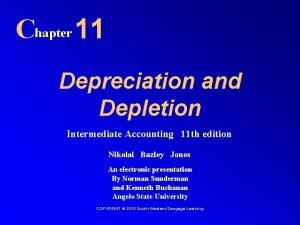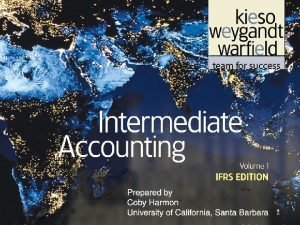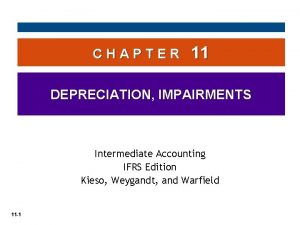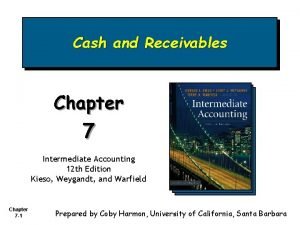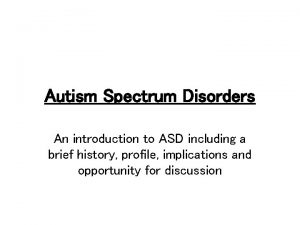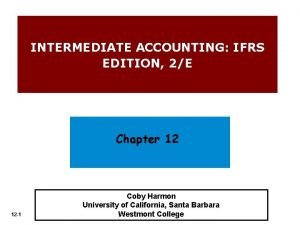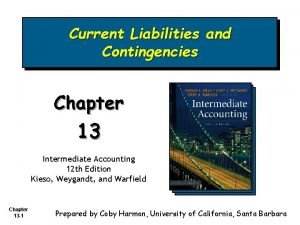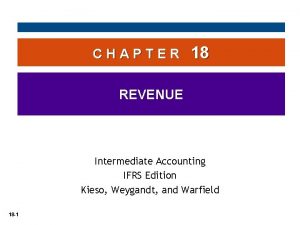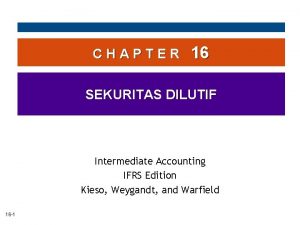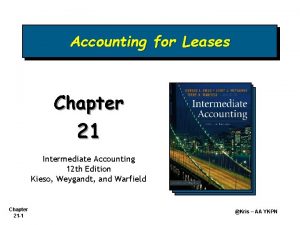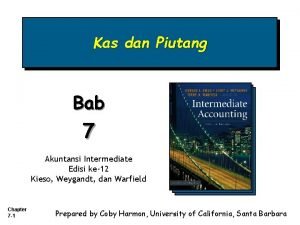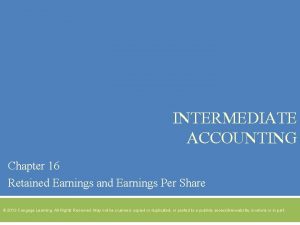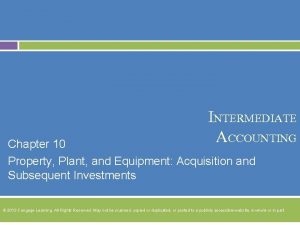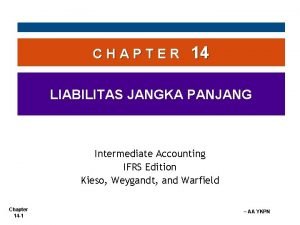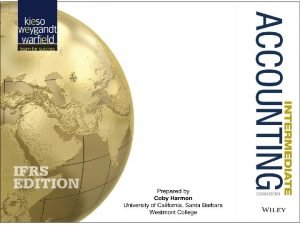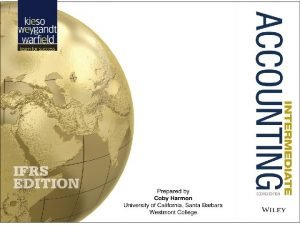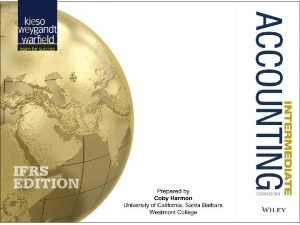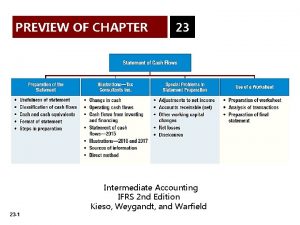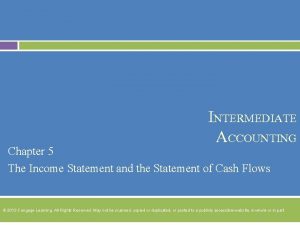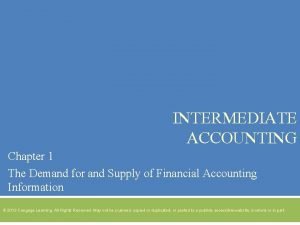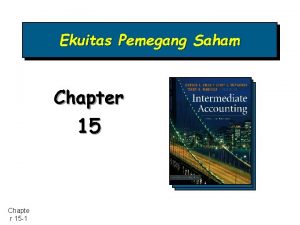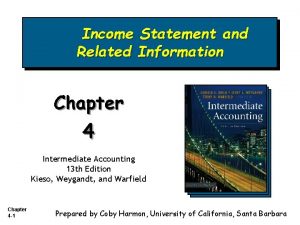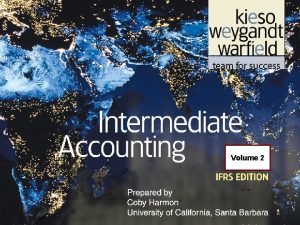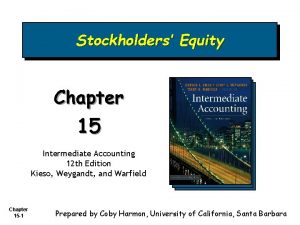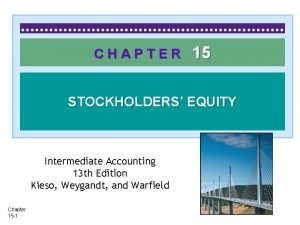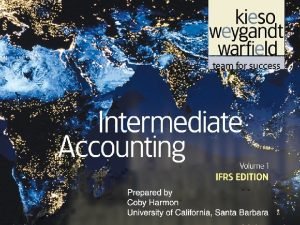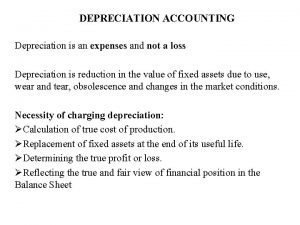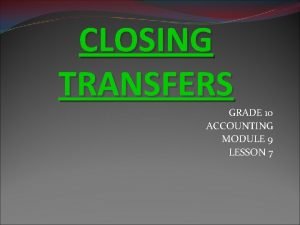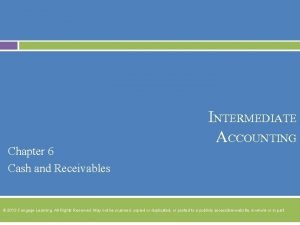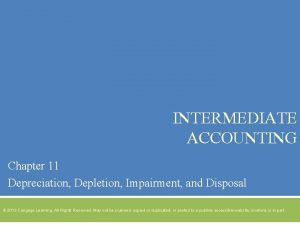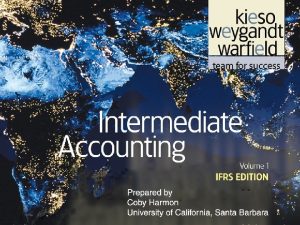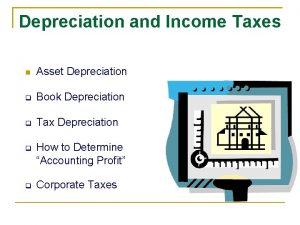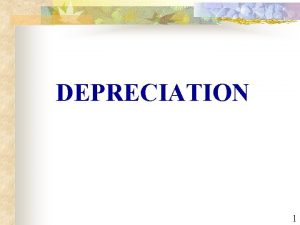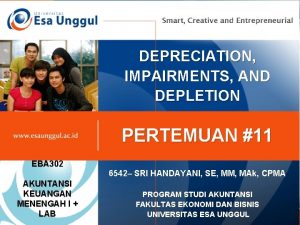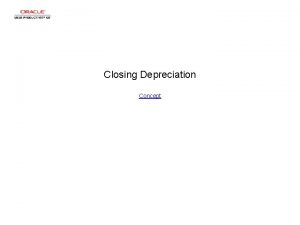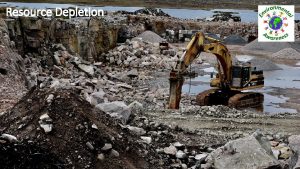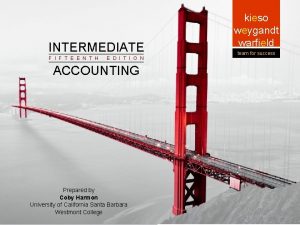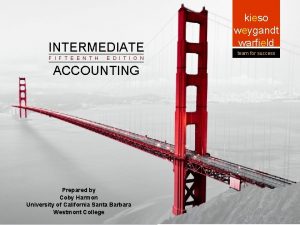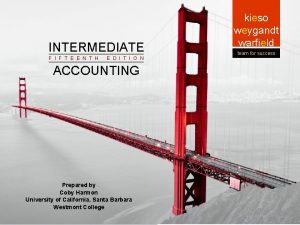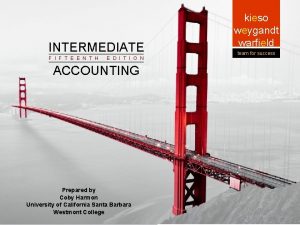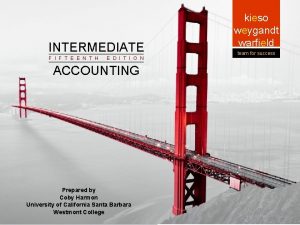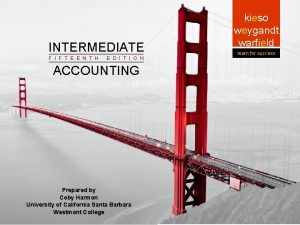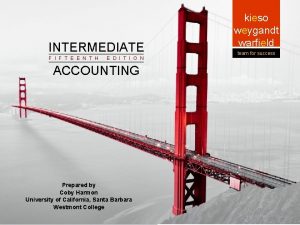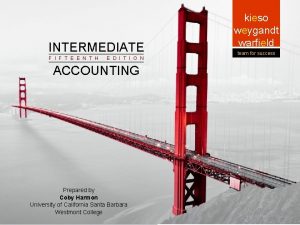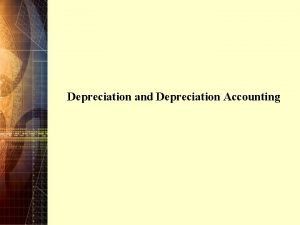Depreciation Impairments and Depletion Chapter 11 Intermediate Accounting






































- Slides: 38

Depreciation, Impairments, and Depletion Chapter 11 Intermediate Accounting 12 th Edition Kieso, Weygandt, and Warfield Chapter 11 -1 Prepared by Coby Harmon, University of California, Santa Barbara

Learning Objectives 1. Explain the concept of depreciation. 2. Identify the factors involved in the depreciation process. 3. Compare activity, straight-line, and decreasing-charge methods of depreciation. 4. Explain special depreciation methods. 5. Explain the accounting issues related to asset impairment. 6. Explain the accounting procedures for depletion of natural resources. 7. Explain how to report and analyze property, plant, equipment, and natural resources. Chapter 11 -2

Depreciation, Impairments, and Depletion Depreciation Impairments Factors involved Methods of depreciation Special methods Recognizing impairments Measuring Impairments Restoration of loss Assets to be disposed of Special issues Chapter 11 -3 Depletion Establishing a base Write-off of resource cost Continuing controversy Special problems Presentation and Analysis Presentation Analysis

Depreciation - Method of Cost Allocation Depreciation is the accounting process of allocating the cost of tangible assets to expense in a systematic and rational manner to those periods expected to benefit from the use of the asset. Allocating costs of long-term assets: Fixed assets = Depreciation expense Intangibles = Amortization expense Natural resources = Depletion expense Chapter 11 -4 LO 1 Explain the concept of depreciation.

Depreciation - Method of Cost Allocation Factors Involved in the Depreciation Process Three basic questions: (1) What depreciable base is to be used? (2) What is the asset’s useful life? (3) What method of cost allocation is best? Chapter 11 -5 LO 2 Identify the factors involved in the depreciation process.

Depreciation - Method of Cost Allocation Methods of Depreciation The profession requires the method employed be “systematic and rational. ” Examples include: (1) Activity method (units of use or production). (2) Straight-line method. (3) Sum-of-the-years’-digits. (4) Declining-balance method. (5) Group and composite methods. (6) Hybrid or combination methods. Chapter 11 -6 Accelerated methods Special methods LO 3 Compare activity, straight-line, and decreasingcharge methods of depreciation.

Depreciation - Method of Cost Allocation Exercise (Depreciation Computations—Four Methods) Robert Parish Corporation purchased a new machine for its assembly process on September 30, 2007. The cost of this machine was $117, 900. The company estimated that the machine would have a salvage value of $12, 900 at the end of its service life. Its life is estimated at 5 years and its working hours are estimated at 1, 000 hours. Year-end is December 31. Instructions: Compute the depreciation expense under the following methods. (a) Straight-line depreciation. (b) Activity method. (c) Sum-of-the-years’-digits. (d) Double-declining balance. Chapter 11 -7 LO 3 Compare activity, straight-line, and decreasingcharge methods of depreciation.

Depreciation - Method of Cost Allocation Exercise (Straight-line Method) Chapter 11 -8 LO 3 Compare activity, straight-line, and decreasingcharge methods of depreciation.

Depreciation - Method of Cost Allocation Exercise (Activity Method) Chapter 11 -9 LO 3 Compare activity, straight-line, and decreasingcharge methods of depreciation.

Depreciation - Method of Cost Allocation Exercise (Sum-of-the-years’-digits Method) Chapter 11 -10 LO 3 Compare activity, straight-line, and decreasingcharge methods of depreciation.

Depreciation - Method of Cost Allocation Exercise (Double-Declining Balance Method) Chapter 11 -11 LO 3 Compare activity, straight-line, and decreasingcharge methods of depreciation.

Depreciation - Method of Cost Allocation Special Depreciation Methods The choice of method depends on the nature of the assets involved: Group method used when the assets are similar in nature and have approximately the same useful lives. Composite approach used when the assets are dissimilar and have different lives. Companies are also free to develop tailor-made depreciation methods, provided the method results in the allocation of an asset’s cost in a systematic and rational manner (Hybrid or Combination Methods). Chapter 11 -12 LO 4 Explain special depreciation methods.

Depreciation - Method of Cost Allocation Special Depreciation Issues (1) How should companies compute depreciation for partial periods? Companies normally compute depreciation on the basis of the nearest full month. (2) Does depreciation provide for the replacement of assets? Funds for the replacement of the assets come from the revenues (3) How should companies handle revisions in depreciation rates? Chapter 11 -13 LO 4 Explain special depreciation methods.

Depreciation - Method of Cost Allocation Changes in Depreciation Rate Accounted for in the period of change and future periods (Change in Estimate) Not handled retrospectively Not considered errors or extraordinary items Chapter 11 -14 LO 4 Explain special depreciation methods.

Change in Estimate Example Arcadia HS, purchased equipment for $510, 000 which was estimated to have a useful life of 10 years with a salvage value of $10, 000 at the end of that time. Depreciation has been recorded for 7 years on a straight-line basis. In 2005 (year 8), it is determined that the total estimated life should be 15 years with a salvage value of $5, 000 at the end of that time. Questions: l What is the journal entry to correct the prior years’ depreciation? l Calculate the depreciation expense for 2005. Chapter 11 -15 No Entry Required LO 4 Explain special depreciation methods.

Change in Estimate Example Equipment cost Salvage value Depreciable base Useful life (original) Annual depreciation After 7 years $510, 000 First, establish NBV - 10, 000 at date of change in estimate. 500, 000 10 years $ 50, 000 x 7 years = $350, 000 Balance Sheet (Dec. 31, 2004) Fixed Assets: Chapter 11 -16 Equipment Accumulated depreciation $510, 000 350, 000 Net book value (NBV) $160, 000 LO 4 Explain special depreciation methods.

Change in Estimate Example Net book value Salvage value (new) Depreciable base Useful life remaining Annual depreciation $160, 000 5, 000 155, 000 8 years $ 19, 375 After 7 years Depreciation Expense calculation for 2005. Journal entry for 2005 Depreciation expense 19, 375 Accumulated depreciation Chapter 11 -17 19, 375 LO 4 Explain special depreciation methods.

Impairments When the carrying amount of an asset is not recoverable, a company records a write-off referred to as an impairment. Events leading to an impairment: a. Decrease in the market value of an asset. b. Change in the manner in which an asset is used. c. Adverse change in legal factors or in the business climate. d. An accumulation of costs in excess of the amount originally expected to acquire or construct an asset. e. A projection or forecast that demonstrates continuing losses associated with an asset. Chapter 11 -18 LO 5 Explain the accounting issues related to asset impairment.

Impairments Measuring Impairments 1. Review events for possible impairment. 2. If the review indicates impairment, apply the recoverability test. If the sum of the expected future net cash flows from the long-lived asset is less than the carrying amount of the asset, an impairment has occurred. 3. Assuming an impairment, the impairment loss is the amount by which the carrying amount of the asset exceeds the fair value of the asset. The fair value is the market value or the present value of expected future net cash flows. Chapter 11 -19 LO 5 Explain the accounting issues related to asset impairment.

Impairments Illustration 11 -16 Accounting for Impairments Chapter 11 -20 LO 5 Explain the accounting issues related to asset impairment.

Impairments E 11 -16 (Impairment) Presented below is information related to equipment owned by Suarez Company at December 31, 2007. Assume that Suarez will continue to use this asset in the future. As of December 31, 2007, the equipment has a remaining useful life of 4 years. Instructions: (a) Prepare the journal entry (if any) to record the impairment of the asset at December 31, 2007. (b) Prepare the journal entry to record depreciation expense for 2008. (c) The fair value of the equipment at December 31, 2008, is $5, 100, 000. Prepare the journal entry (if any) necessary to record this increase in fair value. Chapter 11 -21 LO 5 Explain the accounting issues related to asset impairment.

Impairments (a). 12/31/07 Loss on impairment Accumulated depreciation Chapter 11 -22 3, 200, 000 LO 5 Explain the accounting issues related to asset impairment.

Impairments (b). 12/31/08 Depreciation expense Accumulated depreciation 1, 200, 000 (c). Restoration of any impairment loss is not permitted. Chapter 11 -23 LO 5 Explain the accounting issues related to asset impairment.

Depletion Natural resources, often called wasting assets, include petroleum, minerals, and timber. They have two main features: 1. complete removal (consumption) of the asset, and 2. replacement of the asset only by an act of nature. Depletion is the process of allocating the cost of natural resources. Chapter 11 -24 LO 6 Explain the accounting procedures for depletion of natural resources.

Depletion Establishing a Depletion Base Computation of the depletion base involves four factors: (1) Acquisition cost of the deposit, (2) Exploration costs, (3) Development costs, and (4) Restoration costs. Chapter 11 -25 LO 6 Explain the accounting procedures for depletion of natural resources.

Depletion Write-off of Resource Cost Normally, companies compute depletion on a units-ofproduction method (an activity approach). Thus, depletion is a function of the number of units extracted during the period. Calculation: Total cost – Salvage value Total estimated units available = Depletion cost per unit Units extracted x Cost per unit = Depletion Chapter 11 -26 LO 6 Explain the accounting procedures for depletion of natural resources.

Depletion E 11 -19 (Depletion Computations—Timber) Stanislaw Timber Company owns 9, 000 acres of timberland purchased in 1996 at a cost of $1, 400 per acre. At the time of purchase the land without the timber was valued at $400 per acre. In 1997, Stanislaw built fire lanes and roads, with a life of 30 years, at a cost of $84, 000. Every year Stanislaw sprays to prevent disease at a cost of $3, 000 per year and spends $7, 000 to maintain the fire lanes and roads. During 1998, Stanislaw selectively logged and sold 700, 000 board feet of timber, of the estimated 3, 500, 000 board feet. In 1999, Stanislaw planted new seedlings to replace the trees cut at a cost of $100, 000. Instructions: Determine the depreciation expense and the cost of timber sold related to depletion for 1998. Chapter 11 -27 LO 6 Explain the accounting procedures for depletion of natural resources.

Depletion E 11 -19 (Depletion Computations—Timber) Chapter 11 -28 LO 6 Explain the accounting procedures for depletion of natural resources.

Depletion E 11 -19 (Depletion Computations—Timber) Chapter 11 -29 LO 6 Explain the accounting procedures for depletion of natural resources.

Depletion Continuing Controversy Oil and Gas Industry: Full cost concept Successful efforts concept Special Problems in Depletion Accounting 1. Difficulty of estimating recoverable reserves. 2. Problems of discovery value. 3. Tax aspects of natural resources. 4. Accounting for liquidating dividends. Chapter 11 -30 LO 6 Explain the accounting procedures for depletion of natural resources.

Presentation and Analysis Presentation of Property, Plant, Equipment, and Natural Resources Depreciating assets, use Accumulated Depreciation. Depleting assets may include use of Accumulated Depletion account, or the direct reduction of asset. Basis of valuation (cost) Disclosures Pledges, liens, and other commitments Depreciation expense for the period. Balances of major classes of depreciable assets. Accumulated depreciation. A description of the depreciation methods used. Chapter 11 -31 LO 7 Explain how to report and analyze property, plant, equipment, and natural resources.

Presentation and Analysis Rate of Return on Assets measures a firm’s success in using assets to generate earnings. ROA = 6. 56% = Chapter 11 -32 Net Income Average Total Assets $56, 200 ($1, 030, 400 + 682, 400) / 2 LO 7 Explain how to report and analyze property, plant, equipment, and natural resources.

Presentation and Analysis The analyst obtains further insight into the behavior of ROA by disaggregating it into components of profit margin on sales and asset turnover as follows: Rate of Return on Assets Net Income Average Total Assets Chapter 11 -33 = = Profit Margin on Sales Net Income Sales x x Asset Turnover Sales Average Total Assets LO 7 Explain how to report and analyze property, plant, equipment, and natural resources.

Presentation and Analysis The analyst obtains further insight into the behavior of ROA by disaggregating it into components of profit margin on sales and asset turnover as follows: Rate of Return on Assets = $56, 200 = ($1, 030, 400 + 682, 400) /2 6. 56% Chapter 11 -34 = Profit Margin on Sales $56, 200 x x $300, 000 ($1, 030, 400 + 682, 400) /2 $300, 000 18. 73% Asset Turnover x . 3503 LO 7 Explain how to report and analyze property, plant, equipment, and natural resources.

Presentation and Analysis The profit margin on sales is a measure of the ability of a firm to generate operating income from a particular level of sales. Rate of Return on Assets Net Income = = Average Total Assets 6. 56% Chapter 11 -35 Profit Margin on Sales Net Income x x Sales = 18. 73% Asset Turnover Sales Average Total Assets x . 3503 LO 7 Explain how to report and analyze property, plant, equipment, and natural resources.

Presentation and Analysis The profit margin on sales is a measure of the ability of a firm to generate operating income from a particular level of sales. Rate of Return on Assets Net Income Average Total Assets = = Profit Margin on Sales Net Income Sales x x Asset Turnover Sales Average Total Assets Differences in the profit margin on sales (from year to year) can be studied by analyzing individual revenues and expenses. Chapter 11 -36 LO 7 Explain how to report and analyze property, plant, equipment, and natural resources.

Presentation and Analysis The assets turnover is a measure of a firm’s ability to generate sales from a particular investment in assets. Rate of Return on Assets Net Income = = Average Total Assets 6. 56% Chapter 11 -37 Profit Margin on Sales Net Income x x Sales = 18. 73% Asset Turnover Sales Average Total Assets x . 3503 LO 7 Explain how to report and analyze property, plant, equipment, and natural resources.

Copyright © 2006 John Wiley & Sons, Inc. All rights reserved. Reproduction or translation of this work beyond that permitted in Section 117 of the 1976 United States Copyright Act without the express written permission of the copyright owner is unlawful. Request for further information should be addressed to the Permissions Department, John Wiley & Sons, Inc. The purchaser may make back-up copies for his/her own use only and not for distribution or resale. The Publisher assumes no responsibility for errors, omissions, or damages, caused by the use of these programs or from the use of the information contained herein. Chapter 11 -38
 Composite depreciation rate
Composite depreciation rate Depreciation vs impairment
Depreciation vs impairment Kunci jawaban buku intermediate accounting ifrs chapter 11
Kunci jawaban buku intermediate accounting ifrs chapter 11 Intermediate accounting chapter 7 cash and receivables
Intermediate accounting chapter 7 cash and receivables Wings triad
Wings triad Ignorance modifiers of human acts
Ignorance modifiers of human acts Book value per ordinary share
Book value per ordinary share Chapter 17 intermediate accounting solutions
Chapter 17 intermediate accounting solutions Patent impairment
Patent impairment Current liabilities and contingencies chapter 13
Current liabilities and contingencies chapter 13 Kieso chapter 18
Kieso chapter 18 Intermediate accounting chapter 16
Intermediate accounting chapter 16 Chapter 21 accounting for leases kieso terjemahan
Chapter 21 accounting for leases kieso terjemahan Income tax expense
Income tax expense Bab 7 kas dan piutang
Bab 7 kas dan piutang A restriction/appropriation of retained earnings
A restriction/appropriation of retained earnings Intermediate accounting chapter 10
Intermediate accounting chapter 10 Chapter 2 conceptual framework
Chapter 2 conceptual framework Chapter 14 intermediate accounting kieso bahasa indonesia
Chapter 14 intermediate accounting kieso bahasa indonesia Chapter 3 intermediate accounting
Chapter 3 intermediate accounting Intermediate accounting chapter 15
Intermediate accounting chapter 15 Intermediate accounting chapter 1
Intermediate accounting chapter 1 Liablities
Liablities Conceptual framework of iasb and fasb
Conceptual framework of iasb and fasb Lcnrv adalah
Lcnrv adalah Intermediate accounting chapter 23
Intermediate accounting chapter 23 Income statement example cengage
Income statement example cengage Intermediate accounting chapter 1
Intermediate accounting chapter 1 Contoh soal ekuitas saham
Contoh soal ekuitas saham Types of leases
Types of leases Intermediate accounting chapter 4
Intermediate accounting chapter 4 Intermediate accounting chapter 1
Intermediate accounting chapter 1 Intermediate accounting chapter 17 investments test bank
Intermediate accounting chapter 17 investments test bank Chapter 15 intermediate accounting
Chapter 15 intermediate accounting Large stock dividend journal entry
Large stock dividend journal entry Chapter 12 intermediate accounting
Chapter 12 intermediate accounting Depreciation in accounting
Depreciation in accounting Profit and loss account grade 10
Profit and loss account grade 10 Cash and receivables intermediate accounting
Cash and receivables intermediate accounting
